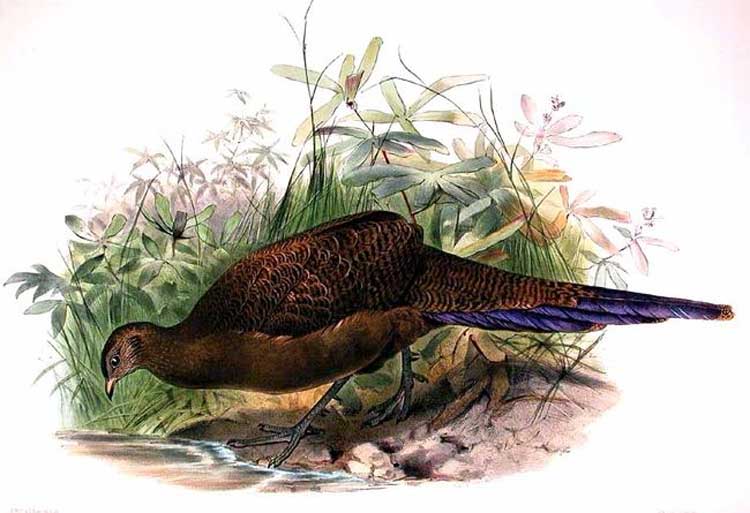
Polyplectron chalcurum
Superregnum: Eukaryota
Cladus: Unikonta
Cladus: Opisthokonta
Cladus: Holozoa
Regnum: Animalia
Subregnum: Eumetazoa
Cladus: Bilateria
Cladus: Nephrozoa
Superphylum: Deuterostomia
Phylum: Chordata
Subphylum: Vertebrata
Infraphylum: Gnathostomata
Megaclassis: Osteichthyes
Cladus: Sarcopterygii
Cladus: Rhipidistia
Cladus: Tetrapodomorpha
Cladus: Eotetrapodiformes
Cladus: Elpistostegalia
Superclassis: Tetrapoda
Cladus: Reptiliomorpha
Cladus: Amniota
Classis: Reptilia
Cladus: Eureptilia
Cladus: Romeriida
Subclassis: Diapsida
Cladus: Sauria
Infraclassis: Archosauromorpha
Cladus: Crurotarsi
Divisio: Archosauria
Cladus: Avemetatarsalia
Cladus: Ornithodira
Subtaxon: Dinosauromorpha
Cladus: Dinosauriformes
Cladus: Dracohors
Cladus: Dinosauria
Ordo: Saurischia
Cladus: Eusaurischia
Subordo: Theropoda
Cladus: Neotheropoda
Cladus: Averostra
Cladus: Tetanurae
Cladus: Avetheropoda
Cladus: Coelurosauria
Cladus: Tyrannoraptora
Cladus: Maniraptoromorpha
Cladus: Maniraptoriformes
Cladus: Maniraptora
Cladus: Pennaraptora
Cladus: Paraves
Cladus: Eumaniraptora
Cladus: Avialae
Infraclassis: Aves
Cladus: Avebrevicauda
Cladus: Pygostylia
Cladus: Ornithothoraces
Cladus: Ornithuromorpha
Cladus: Carinatae
Parvclassis: Neornithes
Cohors: Neognathae
Cladus: Pangalloanserae
Cladus: Galloanseres
Ordo: Galliformes
Familia: Phasianidae
Subfamilia: Phasianinae
Genus: Polyplectron
Species: Polyplectron chalcurum
Subspecies: P. c. chalcurum – P. c. scutulatum
Name
Polyplectron chalcurum (Lesson, 1831: 487) [Protonym: Polyplectron chalcurum]
Type locality: Java (corrected to Bengkulu, west Sumatra).
References
Lesson, R.P. 1830–1831. Traité d'ornithologie, ou, Tableau méthodique des ordres, sous-ordres, familles, tribus, genres, sous-genres et races d'oiseaux : ouvrage entièrement neuf, formant le catalogue le plus complet des espèces réunies dans les collections publiques de la France. F. G. Levrault, Paris. Vol. 1: pp. i–xxxii, 1–659. BHL Reference page. [original description: p. 487]
Vernacular names
English: Bronze-tailed Peacock-pheasant
The bronze-tailed peacock-pheasant (Polyplectron chalcurum) is also known as the Sumatran peacock-pheasant. It is an Indonesian bird.
Description
The bronze-tailed peacock-pheasant is a small, up to 56 cm long, dark brown pheasant with dark grey legs, rather small head and long, narrow tail of sixteen feathers. The tail feathers are chestnut brown with metallic purplish bars near tips. Both sexes are similar. The male has longer tail, two spurs on legs and yellow iris while the unspurred female's is dark brown.
Taxonomy and evolution
The bronze-tailed peacock-pheasant belongs to the family Phasianidae and the genus Polyplectron, which consists of seven peacock-pheasant species. There are two subspecies:
P. c. chalcurum, described by Lesson in 1831, which is known as the southern bronze-tailed peacock-pheasant.
P. c. scutulatum, described by Hoogerwerf in 1941, which is known as the northern bronze-tailed peacock-pheasant.
mtDNA cytochrome b and D-loop as well as the nuclear ovomucoid intron G data confirms that this species belongs to a clade together with the mountain peacock-pheasant, but also the mainland species Germain's peacock-pheasant and grey peacock-pheasant (Kimball et al. 2001).
The molecular data suggests - though not with high confidence - that this species diverged relatively recently from ancestral grey peacock-pheasants. This is quite spurious, since biogeography, its peculiarly derived plumage, and the fact that it is an insular mountain endemic indicate it is derived from a comparatively small founder population; this would confound molecular analyses. What seems clear is that the present species evolved from mainland Southeast Asian stock, probably during the Late Pliocene to Early Pleistocene (3.6-1 mya[2]). The loss of ocelli thus is, contrary to long-held opinion, an autapomorphy, and the southern species of this clade - formerly separated in the genus Chalcurus - are probably not each other's closest relatives.
Distribution and habitat
An Indonesian endemic, the bronze-tailed peacock-pheasant inhabits to mountain forests of west Sumatra.
Behaviour
As with other member in the genus, this elusive bird is shy and very wary. But unlike other peacock-pheasants, it has no ocelli.
Conservation
The bronze-tailed peacock-pheasant is evaluated as Least Concern on the IUCN Red List of Threatened Species.
References
BirdLife International (2016). "Polyplectron chalcurum". IUCN Red List of Threatened Species. 2016: e.T22679361A92812514. doi:10.2305/IUCN.UK.2016-3.RLTS.T22679361A92812514.en. Retrieved 14 November 2021.
Note that the molecular clock calibration method used by Kimball et al. (2001) is now known to be inappropriate, yielding far too low estimates in galliform birds.
Kimball, Rebecca T.; Braun, Edward L.; Ligon, J. David; Lucchini, Vittorio; Randi, Ettore (2001). "A molecular phylogeny of the peacock-pheasants (Galliformes: Polyplectron spp.) indicates loss and reduction of ornamental traits and display behaviours" (PDF). Biol. J. Linn. Soc. 73 (2): 187–198.
Retrieved from "http://en.wikipedia.org/"
All text is available under the terms of the GNU Free Documentation License

